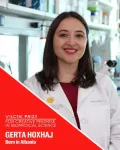(Press-News.org) CAMBRIDGE, MA -- When diagnosing skin diseases based solely on images of a patient’s skin, doctors do not perform as well when the patient has darker skin, according to a new study from MIT researchers.
The study, which included more than 1,000 dermatologists and general practitioners, found that dermatologists accurately characterized about 38 percent of the images they saw, but only 34 percent of those that showed darker skin. General practitioners, who were less accurate overall, showed a similar decrease in accuracy with darker skin.
The research team also found that assistance from an artificial intelligence algorithm could improve doctors’ accuracy, although those improvements were greater when diagnosing patients with lighter skin.
While this is the first study to demonstrate physician diagnostic disparities across skin tone, other studies have found that the images used in dermatology textbooks and training materials predominantly feature lighter skin tones. That may be one factor contributing to the discrepancy, the MIT team says, along with the possibility that some doctors may have less experience in treating patients with darker skin.
“Probably no doctor is intending to do worse on any type of person, but it might be the fact that you don’t have all the knowledge and the experience, and therefore on certain groups of people, you might do worse,” says Matt Groh PhD ’23, an assistant professor at the Northwestern University Kellogg School of Management. “This is one of those situations where you need empirical evidence to help people figure out how you might want to change policies around dermatology education.”
Groh is the lead author of the study, which appears today in Nature Medicine. Rosalind Picard, an MIT professor of media arts and sciences, is the senior author of the paper.
Diagnostic discrepancies
Several years ago, an MIT study led by Joy Buolamwini PhD ’22 found that facial-analysis programs had much higher error rates when predicting the gender of darker skinned people. That finding inspired Groh, who studies human-AI collaboration, to look into whether AI models, and possibly doctors themselves, might have difficulty diagnosing skin diseases on darker shades of skin — and whether those diagnostic abilities could be improved.
“This seemed like a great opportunity to identify whether there’s a social problem going on and how we might want fix that, and also identify how to best build AI assistance into medical decision-making,” Groh says. “I’m very interested in how we can apply machine learning to real-world problems, specifically around how to help experts be better at their jobs. Medicine is a space where people are making really important decisions, and if we could improve their decision-making, we could improve patient outcomes.”
To assess doctors’ diagnostic accuracy, the researchers compiled an array of 364 images from dermatology textbooks and other sources, representing 46 skin diseases across many shades of skin.
Most of these images depicted one of eight inflammatory skin diseases, including atopic dermatitis, Lyme disease, and secondary syphilis, as well as a rare form of cancer called cutaneous T-cell lymphoma (CTCL), which can appear similar to an inflammatory skin condition. Many of these diseases, including Lyme disease, can present differently on dark and light skin.
The research team recruited subjects for the study through Sermo, a social networking site for doctors. The total study group included 389 board-certified dermatologists, 116 dermatology residents, 459 general practitioners, and 154 other types of doctors.
Each of the study participants was shown 10 of the images and asked for their top three predictions for what disease each image might represent. They were also asked if they would refer the patient for a biopsy. In addition, the general practitioners were asked if they would refer the patient to a dermatologist.
“This is not as comprehensive as in-person triage, where the doctor can examine the skin from different angles and control the lighting,” Picard says. “However, skin images are more scalable for online triage, and they are easy to input into a machine-learning algorithm, which can estimate likely diagnoses speedily.”
The researchers found that, not surprisingly, specialists in dermatology had higher accuracy rates: They classified 38 percent of the images correctly, compared to 19 percent for general practitioners.
Both of these groups lost about four percentage points in accuracy when trying to diagnose skin conditions based on images of darker skin — a statistically significant drop. Dermatologists were also less likely to refer darker skin images of CTCL for biopsy, but more likely to refer them for biopsy for noncancerous skin conditions.
A boost from AI
After evaluating how doctors performed on their own, the researchers also gave them additional images to analyze with assistance from an AI algorithm the researchers had developed. The researchers trained this algorithm on about 30,000 images, asking it to classify the images as one of the eight diseases that most of the images represented, plus a ninth category of “other.”
This algorithm had an accuracy rate of about 47 percent. The researchers also created another version of the algorithm with an artificially inflated success rate of 84 percent, allowing them to evaluate whether the accuracy of the model would influence doctors’ likelihood to take its recommendations.
“This allows us to evaluate AI assistance with models that are currently the best we can do, and with AI assistance that could be more accurate, maybe five years from now, with better data and models,” Groh says.
Both of these classifiers are equally accurate on light and dark skin. The researchers found that using either of these AI algorithms improved accuracy for both dermatologists (up to 60 percent) and general practitioners (up to 47 percent).
They also found that doctors were more likely to take suggestions from the higher-accuracy algorithm after it provided a few correct answers, but they rarely incorporated AI suggestions that were incorrect. This suggests that the doctors are highly skilled at ruling out diseases and won’t take AI suggestions for a disease they have already ruled out, Groh says.
“They’re pretty good at not taking AI advice when the AI is wrong and the physicians are right. That’s something that is useful to know,” he says.
While dermatologists using AI assistance showed similar increases in accuracy when looking at images of light or dark skin, general practitioners showed greater improvement on images of lighter skin than darker skin.
“This study allows us to see not only how AI assistance influences, but how it influences across levels of expertise,” Groh says. “What might be going on there is that the PCPs don't have as much experience, so they don’t know if they should rule a disease out or not because they aren’t as deep into the details of how different skin diseases might look on different shades of skin.”
The researchers hope that their findings will help stimulate medical schools and textbooks to incorporate more training on patients with darker skin. The findings could also help to guide the deployment of AI assistance programs for dermatology, which many companies are now developing.
###
The research was funded by the MIT Media Lab Consortium and the Harold Horowitz Student Research Fund.
END
Doctors have more difficulty diagnosing disease when looking at images of darker skin
Dermatologists and general practitioners are somewhat less accurate in diagnosing disease in darker skin, a new study finds; Used correctly, AI may be able to help
2024-02-06
ELSE PRESS RELEASES FROM THIS DATE:
Vilcek Foundation awards $250,000 to immigrant scientists
2024-02-06
The Vilcek Foundation announces the recipients of the 2024 Vilcek Foundation Prizes in Biomedical Science. Awarded annually since 2006, the prizes recognize outstanding immigrant scientists at the forefront of their fields, and celebrate the importance of immigrant contributions to scientific research and discovery in the United States. In 2024, the foundation awards $250,000 in prizes to Luciano Marraffini (b. Argentina), Gerta Hoxhaj (b. Albania), Tomasz Nowakowski (b. Poland) and Takanori Takebe (b. Japan).
“With the 2024 Vilcek Foundation Prizes in Biomedical Science, we honor scientists who have ...
Covid vaccine for pregnant women safe for newborn infants
2024-02-06
No increased risks for babies, and for some serious neonatal complications lower risks. This is the result of the largest study to date on the safety of newborn babies whose mothers were vaccinated against COVID-19 during pregnancy. The study is a collaboration between Swedish and Norwegian researchers and is published in the journal JAMA.
COVID-19 vaccination in pregnancy was not associated with any increased risks in newborn infants. On the contrary, the study of nearly 200,000 newborns in Sweden and Norway showed that babies born by women who chose to be vaccinated ...
Neonatal outcomes after COVID-19 vaccination in pregnancy
2024-02-06
About The Study: In this population-based study from Sweden and Norway that included 94,000 infants exposed to COVID-19 vaccination during pregnancy and 102,000 control infants born between June 2021 and January 2023, vaccination of pregnant individuals with mRNA COVID-19 vaccines was not associated with increased risks of neonatal adverse events in their infants.
Authors: Mikael Norman, M.D., Ph.D., of the Karolinska Institutet in Stockholm, is the corresponding author.
To access the embargoed study: Visit our For The Media website at this link https://media.jamanetwork.com/
(doi:10.1001/jama.2023.26945)
Editor’s Note: Please ...
Effectiveness of bivalent mRNA COVID-19 vaccines in preventing SARS-CoV-2 infection in children and adolescents ages 5 to 17
2024-02-06
About The Study: The bivalent COVID-19 vaccines protected children and adolescents against SARS-CoV-2 infection and symptomatic COVID-19 in this study including 2,959 participants ages 5 to 17 years. These data demonstrate the benefit of COVID-19 vaccine in children and adolescents. All eligible children and adolescents should remain up to date with recommended COVID-19 vaccinations.
Authors: Leora R. Feldstein, Ph.D., of the Centers for Disease Control and Prevention in Atlanta, is the corresponding author.
To access the embargoed study: Visit our For The Media website ...
Pancreatic Cancer: Italian scientists found out how the tumor escapes therapies
2024-02-06
Italian scientists from Università Cattolica at Rome discovered an important genetic mechanism that pancreatic cancer cells employ to evade therapies, paving the way to new drugs for a killer disease. The tumor evades treatments by implementing a 'favorable genetic reshuffling,' strategically playing its best cards to thwart cures. This finding is the result of a study published today in the journal Cell Reports Medicine, coordinated by Claudio Sette, Professor of Human Anatomy at the Catholic University, and Director of the "Organoids Facility" at the Policlinico Universitario A. Gemelli ...
Gun violence exposure and suicide among black adults
2024-02-06
About The Study: Gun violence exposure among Black adults in the U.S. was significantly associated with lifetime suicidal ideation and behavior in this study that included 3,015 Black adults. Public health efforts to substantially reduce interpersonal gun violence may yield additional benefits by decreasing suicide among Black individuals in the U.S.
Authors: Daniel C. Semenza, Ph.D., of Rutgers University in Camden, New Jersey, is the corresponding author.
To access the embargoed study: Visit our For The Media website at this link https://media.jamanetwork.com/
(doi:10.1001/jamanetworkopen.2023.54953)
Editor’s ...
Cancer risk following smoking cessation
2024-02-06
About The Study: Sustained smoking cessation was associated with a significantly reduced risk of cancer after 10 years since quitting in this study of 2.9 million Korean adults. Quitting at any age helped reduce the cancer risk, and especially for lung cancer, early cessation before middle age exhibited a substantial risk reduction.
Authors: Jin-Kyoung Oh, Ph.D., of the National Cancer Center Graduate School of Cancer Science and Policy in Goyang, Republic of Korea, is the corresponding author.
To access the embargoed study: Visit our For The Media website at ...
Understanding the moon’s history with Chang’e-5 sample
2024-02-06
WASHINGTON, Feb. 6, 2024 – Earth’s moon achieved its Swiss cheese appearance from celestial objects crashing into its surface, forming impact craters. But craters weren’t all that was left behind; the intense pressure and temperature of such a collision also impacts the rocks and dust covering the lunar surface, known as regolith, altering its mineral composition and structure. Analyzing the resulting minerals provides modern researchers clues to the moon’s past.
China’s Chang’e-5, the first lunar sample ...
Inner ear of miocene fossil ape gives clues to evolution of bipedalism
2024-02-06
A new study of a 7–8-million-year-old extinct fossil ape from China called Lufengpithecus offers new insights into the evolution of human bipedalism.
The study, published in The Innovation, was conducted by a team from the Institute of Vertebrate Paleontology and Paleoanthropology (IVPP) of the Chinese Academy of Sciences, the Yunnan Institute of Cultural Relics and Archaeology (YICRA), and New York University (NYU).
Humans and our closest relatives, the living apes, display a remarkable diversity of locomotor abilities, from walking upright on two legs to climbing and clambering in trees to walking using all four limbs. Scientists have long been fascinated ...
GPT-3 transforms chemical research
2024-02-06
Artificial intelligence is growing into a pivotal tool in chemical research, offering novel methods to tackle complex challenges that traditional approaches struggle with. One subtype of artificial intelligence that has seen increasing use in chemistry is machine learning, which uses algorithms and statistical models to make decisions based on data and perform tasks that it has not been explicitly programmed for.
However, to make reliable predictions, machine learning also demands large amounts of data, which isn’t always available in chemical research. Small chemical datasets simply do not provide enough information for these algorithms to train on, which limits their effectiveness.
In ...
LAST 30 PRESS RELEASES:
Duke and Duke-NUS’ joint cross-population research to uncover "East-West" differences in disease and care
Scientists to ‘spy’ on cancer- immune cell interactions using quantum technology breakthrough
Tech savvy users have most digital concerns
Making lighter work of calculating fluid and heat flow
Normalizing blood sugar can halve heart attack risk
Lowering blood sugar cuts heart attack risk in people with prediabetes
Study links genetic variants to risk of blinding eye disease in premature infants
Non-opioid ‘pain sponge’ therapy halts cartilage degeneration and relieves chronic pain
AI can pick up cultural values by mimicking how kids learn
China’s ecological redlines offer fast track to 30 x 30 global conservation goal
Invisible indoor threats: emerging household contaminants and their growing risks to human health
Adding antibody treatment to chemo boosts outcomes for children with rare cancer
Germline pathogenic variants among women without a history of breast cancer
Tanning beds triple melanoma risk, potentially causing broad DNA damage
Unique bond identified as key to viral infection speed
Indoor tanning makes youthful skin much older on a genetic level
Mouse model sheds new light on the causes and potential solutions to human GI problems linked to muscular dystrophy
The Journal of Nuclear Medicine ahead-of-print tip sheet: December 12, 2025
Smarter tools for peering into the microscopic world
Applications open for funding to conduct research in the Kinsey Institute archives
Global measure underestimates the severity of food insecurity
Child survivors of critical illness are missing out on timely follow up care
Risk-based vs annual breast cancer screening / the WISDOM randomized clinical trial
University of Toronto launches Electric Vehicle Innovation Ontario to accelerate advanced EV technologies and build Canada’s innovation advantage
Early relapse predicts poor outcomes in aggressive blood cancer
American College of Lifestyle Medicine applauds two CMS models aligned with lifestyle medicine practice and reimbursement
Clinical trial finds cannabis use not a barrier to quitting nicotine vaping
Supplemental nutrition assistance program policies and food insecurity
Switching immune cells to “night mode” could limit damage after a heart attack, study suggests
URI-based Global RIghts Project report spotlights continued troubling trends in worldwide inhumane treatment
[Press-News.org] Doctors have more difficulty diagnosing disease when looking at images of darker skinDermatologists and general practitioners are somewhat less accurate in diagnosing disease in darker skin, a new study finds; Used correctly, AI may be able to help



